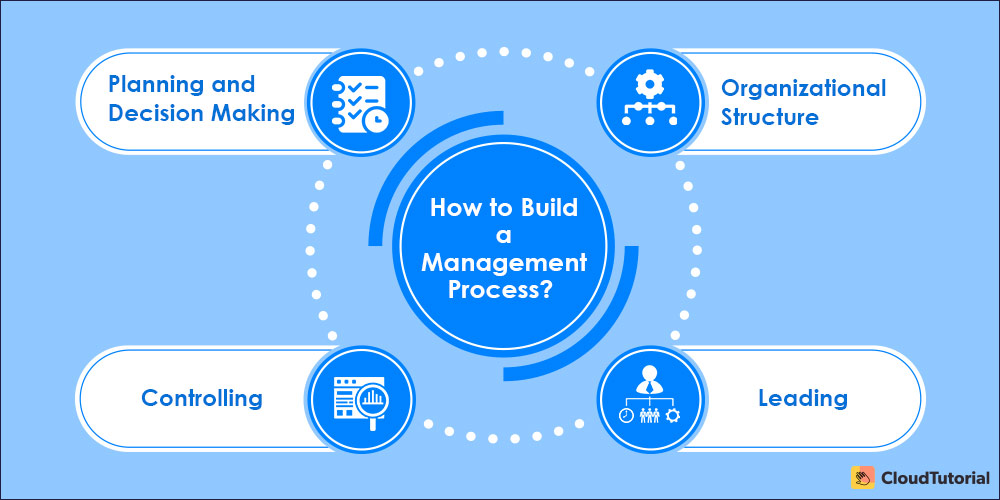As a manager, managing a team or a project can be daunting sometimes. More so if you have stepped into the manager’s shoes for the first time, it’s like climbing a rugged mountain, but without any climbing gear.
Maintaining your relevancy in organizations can be a challenge. Hence, this blog aims to help you build a management process, which allows your team members to achieve organizational goals. So, let’s explore more.
Table of Content
What is a Management Process?
The management process is a series of steps that you take for planning, organizing, and leading the projects. You should document the management process in an internal wiki as a reference. Why?
Let’s say you have taken leave due to falling ill. How will your team or other managers handle the project? That’s where this internal wiki will help them out. It will make it easier for them to follow the core process in your absence.
But, what does the business process management look like in reality?

Here is how it would look like for a blogging team.
- Plan. Set traffic and lead goals. Decide on content strategy.
- Organize. Assign topics to content writers.
- Lead. Provide content writers with all the resources they need for their writing.

Need to Make and Publish Your Own FAQ Pages?
You’ve come to the right spot! CloudTutorial provides FREE templates to let you create and publish FAQ Pages and vital docs in a snap!
Why is a Management Process Important?
Management processes help managers and employees accomplish their tasks within time.
- It ensures that all the tasks get compiled consistently, making it easier to streamline the current functions and take on new challenging future activities.
- A good process management system also gives employees more freedom in tackling their tasks. Giving more autonomy at work is a basic psychological need, and it will make your employees happier.
How to Build a Management Process?

The management team shouldn’t try to dictate policies and procedures on how the employees should perform their tasks. It will kill innovation and will be detrimental to employee engagement. Here are the steps you can undertake to implement a management system for your current and future projects.
There are four functions of process management that automate tasks: Planning, Organizing, Leading, and Controlling. As a manager, these four functions will help you accomplish your desired goals.
Planning and Decision Making – Deciding the Course of Action For Business Goals
Planning is the first stage of the process management system. Here, the main activity is to establish challenging yet feasible business goals and the best approach for attaining them.
For an easy understanding, the planning phase is further divided into three phases:
Decide Why and How You Will Accomplish the Objectives
Don’t focus too much on results. Instead, concentrate on the process improvement that will help you accomplish those results. Decide on why and how you will achieve the objectives, not just on what you will accomplish.
I suggest setting inspirational goals instead of numeric ones.
Let’s say that you want your team to have the highest output in the entire organization. After that, you can set key results which are numeric to measure the progress towards attaining those objectives.
Before you start working on your objectives, set an expectation on how you will accomplish the goals. Why? It’s because:
- If you achieve the goal 100% of the time, then it is an easy one.
- If you are never accomplishing anything that you set out to, it could be that your goal is impossible to reach.
Brainstorming
Many departmental heads organzine brainstorming assemblies to produce novel ideas. But did you know that psychologists consider brainstorming as one of the worst ideas for collaboration? Why? It’s because of the cognitive bias, which impacts the creativity of the team members.
- In groupthink, people don’t want to oppose others’ ideas. Hence, they agree with the most accepted opinion, not with the most creative one.
- Then there is evaluation apprehension. Here introverts are less likely to share their ideas than extroverts. It leads to one personality type dominating the entire process of communication.
- Finally, there is another cognitive bias called production blocking. Here the number of people participating in the brainstorming session limits the number of ideas everyone can pitch in the entire session.
- It reduces the number of ideas the session generates due to people not getting the chance to share their opinions.
So, how to avoid falling victim to these cognitive biases?
- Ask your team members to brainstorm ideas on their own and share them with you in private. It will help them think of better ones. Don’t believe it? Here is research that says that brainstorming alone leads to a higher quantity and better quality of ideas.
- Carry out secret polls to recognize which scheme your department believes is the best. It will avoid any social influences that can affect people’s decisions regarding the plan.
Divide the Project into Smaller Parts
Managers should divide their projects into smaller parts. It will give their team more opportunities to feel accomplished at their work. When you complete a challenging task, it will trigger the release of dopamine in your brain. Hence, dividing the project into smaller yet challenging tasks will motivate your team to get things done.
Let me share the case story of Wistia to demonstrate how dividing the project into smaller parts helps the organizations in the long run.
Case story of Wistia:
Wistia wanted to grow as much as possible and within a short period. The organization began to set ambitious goals for achieving its revenue target. They focused more on short-term thinking, which proved detrimental to the creativity of their employees.
In the end, the only thing that the organization achieved was killing the motivation of its workforce. But, Wistia learned from its mistakes and began to set more realistic objectives. The organization noticed that their employees started feeling more creative and motivated in their work.
It was because the goals the organization had set were now achievable. The workforce got more time to think of innovative methods for achieving their objectives. Wistia was able to accomplish its goals and even exceed them regularly.
Organizational Structure
In the next stage of the process management functions, managers need to define every role on their team and delegate authority accordingly.
- Everyone on your team should get well versed with their roles.
- The organizational activities will improve the efficiency and effectiveness of your team.
- Your team members will understand how much decision-making power they have, their responsibilities in the team, and what kind of work their co-workers are doing.
- It will help everyone focus on their work and not interfere with another person’s work.
- The communication process between the team members will also be much better.
- The DACI framework helps you designate the amount of decision-making authority for each role on your team.
- It’s also essential to match your team member’s skills with the appropriate role. The better suited they are in it, the more your team members will feel satisfied with their job. In return, they will give a better performance in their task.
Want a Knowledge Base Software that is User-Friendly?
CloudTutorial is a simple and easy-to-use software that makes creating articles, FAQs, help-desks, and other documents.
Leading
IIn this stage of the business process management system, organizing managers have to lead their team to the finish line. I will share with you three best management practices to help you in the process improvement.
Ensure Your Team Has a Purpose and Meaningful Responsibility
Emotions drive action. Simon Sinek, a motivational speaker, says that the most primal part of the brain, the limbic system, is in charge of our emotions and decision-making processes.
As a manager, do you want your team to give their best individual efforts to the task at hand? Then try to emphasize a deeper meaning behind the responsibilities that each of the team members has.
The team should deeply care about the work they do. There is no point in doing the job if your mission doesn’t resonate with those who work under you.
Focus on the Process
Prioritize systems instead of the goal. Everyone has objectives but having a magnificent purpose doesn’t lead to exceptional results. What differentiates a successful team from an unsuccessful one is the management system they implement that will help them deliver an exceptional outcome.
Business process management is your team’s differentiator. If the employees are intrinsically motivated, then it will lead to superb results
Establish Psychological Safety
Is your team afraid to fail? That’s a big red flag. Good work culture is where people aren’t scared to fail.
Humans have a primal desire to feel safe. Having a safe culture will foster the trust and loyalty of your team towards you. It will motivate them to work harder on your project. When people feel safe psychologically, they tend to come up with creative ideas. So, how can a management system create such an environment?
- First, don’t judge. Encourage your team to challenge the status quo.
- Hear every idea that comes from your team. It doesn’t matter if it is good or bad. Hear it sincerely.
- Failure should get seen as an opportunity to learn and improve the different processes.
Controlling – Monitoring and Evaluating Managerial Activities
Managers often monitor the progress towards achieving the specific objectives. It is known as ‘controlling.’ Controlling functions are measuring, comparing, finding deviation, and correcting those deviations that emerge.
Let’s say if deviations occur in the process, a correction will get indicated. If the results are different from the plan, then the employee responsible for it should get identified. After that, required action should get taken to improve the performance.
These main functions get used for those organizational activities which are getting performed to achieve specific goals. There are many means of controlling, like inspection records, budget for expenses, and reports of work hours lost. Each process performance measurement indicates whether plans are working out or not.
The outcomes get controlled by controlling what employees do. It is an essential management function process. Planning without controlling is a waste of time. It enables the accomplishment of the specific plan.
Controlling is a function of management that seeks planned results from everyone that is part of the company. This function helps measure the progress towards goals, brings attention to any deviations, and indicates corrective action towards them.
Planning, staffing, organizing, leading, and controlling are five functions of management.
Project initiation, project planning, project execution, project monitoring, and controlling project closing. These five phases together make up the project management process. .
In this blog, we went through the four most important functions of a management process. We discussed each function in detail, explaining its meaning and importance.
As a manager, if you are facing situations where your team is experiencing difficulty in their work, then you can opt for a knowledge base platform. You can help them resolve their issues and answer their queries in real-time with CloudTutorial which is a top knowledge-sharing platform.
Create a knowledge base, SOPs, and foster a culture of knowledge sharing with our software. Sign up for FREE and deliver better overall results in their work.
Try it out before you decide.
Create a test article NOW!
Using this tool, all you have to do is add your first test article and see how it looks. Now, you don’t have to sign-up or login into CloudTutorial software just to check how your first article appears.

